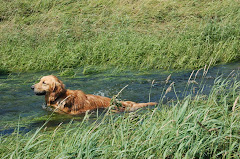 The other Snap test shown is the Foal CITE test. This test tests the IgG or antibody level in newborn foals. Foals obtain IgG in the first 12-18 hours from their mother's colostrum. This level should be over 800 mg/dl to provide passive immunity against infection in the newborn foal. We recommend this test on all newborn foals and we perform this test on all foals that are born at the clinic. With this test, the control dots are the two blue dots above the single test sample dot. As you can tell, the control dot on the left is a lighter shade of blue than the control dot on the right. The control dot on the left is the 400 mg/dl level and the control dot on the left is the 800 mg/dl level. The test sample dot should be as dark blue or darker than the right hand control dot for the sample to be over 800 mg/dl. Basically, the darker the better. Pale blue or white means the foal's IgG or antibody is low.
The other Snap test shown is the Foal CITE test. This test tests the IgG or antibody level in newborn foals. Foals obtain IgG in the first 12-18 hours from their mother's colostrum. This level should be over 800 mg/dl to provide passive immunity against infection in the newborn foal. We recommend this test on all newborn foals and we perform this test on all foals that are born at the clinic. With this test, the control dots are the two blue dots above the single test sample dot. As you can tell, the control dot on the left is a lighter shade of blue than the control dot on the right. The control dot on the left is the 400 mg/dl level and the control dot on the left is the 800 mg/dl level. The test sample dot should be as dark blue or darker than the right hand control dot for the sample to be over 800 mg/dl. Basically, the darker the better. Pale blue or white means the foal's IgG or antibody is low. Another common Snap test used tests for Feline Leukemia Virus and Feline Immunodeficiency Virus in cats.
Another common Snap test used tests for Feline Leukemia Virus and Feline Immunodeficiency Virus in cats. Fecal Tests



Urinalysis
Another common lab test performed is the urinalysis. Much information can be obtained from a urine sample. A urine sample can be collected from a pet in three ways. A "free catch" sample can be obtained while the pet is actually urinating.....which can be challenging! The drawback to analyzing a voided sample is the urine can be contaminated with bacteria, cells or blood from the reproductive tract which can make analyzing the results difficult. A urine sample can be obtained by catheterizing a pet. However, this can also result in blood and bacteria from the procedure.....plus it is uncomfortable for the pet. The third and preferred method of obtaining a urine sample is by cystocentesis. Cystocentesis involves introducing a small needle, preferably ultrasound guided, into the bladder and removing a urine sample with a syringe. This method is actually tolerated very well by the pet and provides the most accurate sample for analysis. A urinalysis consists of three parts. The first part involves dipping a reagent stick in the urine to test for blood, protein, glucose, bilirubin, pH and ketones. The second part involves testing the specific gravity or concentration of urine using a handheld refractometer. The last part involves looking at a centrifuged portion of the urine sample under the microscope. By doing so, we can look for bacteria, red blood cells, white blood cells, abnormal cells and crystals. This picture shows the reagent strip and the handheld refractometer. 
This ends the first part of "In House Diagnostic Tests". For the most part, these are common, routine tests performed on a daily basis at the Arthur Veterinary Clinic. In the second part, I will discuss some of the more sophisticated tests.










No comments:
Post a Comment